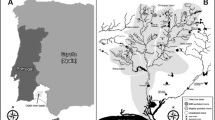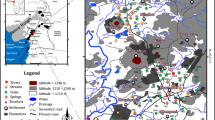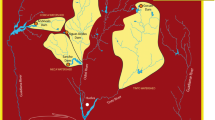Abstract
Aljustrel mining area (South Portugal) is a part of the Iberian Pyrite Belt and encloses six sulfide mineral masses. This mine is classified of high environmental risk due to the large tailings’ volume and acid mine drainage (AMD)-affected waters generated by sulfides’ oxidation. The use of biological indicators (e.g., diatoms) revealed to be an important tool to address the degree of AMD contamination in waters. Multivariate analysis has been used as a relevant approach for the characterization of AMD processes. Cluster analysis was used to integrate the significant amount and diversity of variables (physicochemical and biological), discriminating the different types of waters, characterized by the high complexity occurring in this region. The distinction of two main marked phenomena was achieved: (1) the circumneutral-Na-Cl water type (sites DA, PF, BX, BF, RO, CB), expressing the geological contributions of the Cenozoic sediments of Sado river basin, with high diatom diversity (predominating brackish diatoms as Entomoneis alata); and (2) the acid–metal-sulfated water type (sites BM, JU, RJ, AA, MR, BE, PC, AF), reflecting both the AMD contamination and the dissolution of minerals (e.g., silicates) from the hosting rocks, potentiated by the extremely low pH. This last group of sites showed lower diatom diversity but with typical diatoms from acid- and metal-contaminated waters (e.g., Pinnularia aljustrelica). In addition to these two water types, this hierarchical classification method also allowed to distinguish individual cases in subclusters, for example, treated dams (DC, DD), with alkaline substances (lime/limestone), that changed the physicochemical dynamics of the contaminated waters.






Similar content being viewed by others
References
Alpers, C. N., Blowes, D. W., Nordstrom, D. K., & Jambor, J. L. (1994a). Secondary minerals and acid mine-water chemistry. In J. L. Jambor & D. W. Blowes (Eds.), Environmental geochemistry of sulphide mine-wastes. Short course handbook (Vol. 22, pp. 247–270). Ontario: Mineralogical Association of Canada.
Alpers, C. N., Nordstrom, D. K., & Thompson, J. M. (1994b). Seasonal variations of Zn/Cu ratios in acid mine water from Iron Mountain, California. In C. N. Alpers & D. W. Blowes (Eds.), Environmental geochemistry of sulfide oxidation. ACS symposium series 550 (pp. 324–344). Washington, D. C.: American Chemical Society.
Andrade, R. F. D., & Schermerhorn, L. J. G. (1971). Aljustrel e Gavião. Livro-Guia n°4. I Congresso Hispano-Luso-Americano de Geologia Económica (pp. 32–59). Lisboa: Direcção-Geral de Minas e Serviços Geológicos.
Barriga, F. J. A. S., Carvalho, D., & Ribeiro, A. (1997). Introdution to the Iberian pyrite belt. In F. J. A. S. Barriga, D. Carvalho, & T. B. Thompson (Eds.), SEG neves field conference. Guidebook series (Vol. 27, pp. 1–20). Littleton: Society of Economic Geologists, Inc.
Bisquerra, R. (1989). Introducción conceptual al análisis multivariable. Barcelona: Promociones y Publicaciones Universitarias.
Carvalho, D., Barriga, F. J. A. S., & Munhá, J. (1999). Bimodal-siliciclastic systems—The case of the Iberian pyrite belt. Reviews in Economic Geology, 8, 375–408.
Chambel, A., & Almeida, C. (1998). Origin of highly mineralised waters in a semi-arid area of the South Portugueses Zone (Portugal). In Brahana (Ed.), Gambling with groundwater—Physical, chemical, and biological aspects of aquifer–stream relations (pp. 419–424). Las Vegas: American Institute of Hydrology.
Decreto-Lei n.° 31/2013 de 22 de Fevereiro. Procede à primeira alteração ao Decreto-Lei n.° 10/2010, de 4 de fevereiro, que estabelece o regime jurídico a que está sujeita a gestão de resíduos das explorações de depósitos minerais e de massas minerais.
Directiva n° 2006/21/CE do Parlamento Europeu e do Conselho de 15 de Março de 2006 relativa à gestão dos resíduos de indústrias extractivas e que altera a Directiva 2004/35/CE.
Durães, N., Bobos, I., & Ferreira da Silva, E. (2017). Speciation and precipitation of heavy metals in high-metal and high-acid mine waters from the Iberian pyrite belt (Portugal). Environmental Science and Pollution Research, 24(5), 4562–4576.
Ferreira da Silva, E., Almeida, S. F. P., Nunes, M. L., Luís, A. T., Borg, F., Hedlund, M., et al. (2009). Heavy metal pollution downstream the abandoned Coval da Mó mine (Portugal) and associated effects on epilithic diatom communities. Science of the Total Environment, 407, 5620–5636.
Fourtanier, E., & Kociolek, J. P. (2011). Catalogue of diatom names. California Academy of Sciences. http://research.calacademy.org/research/diatoms/names/index.asp.
Gaspar, O. (1996). Microscopia e petrologia de minérios, aplicada à génese, exploração e mineralurgia dos sulfuretos maciços dos jazigos de Aljustrel e Neves Corvo. Estud. Notas e Trabalhos, 38, 3–195.
Grande, J. A., Aroba, J., Andujar, J. M., Gómez, T., De la Torre, M. L., Borrego, J., et al. (2011). Tinto versus Odiel: Two AMD polluted rivers and an unresolved issue an artificial intelligence approach. Water Resources Management, 25(14), 3575–3594.
Grande, J. A., Borrego, J., de la Torre, M. L., & Sáinz, A. (2003). Application of cluster analysis to the geochemistry zonation of the estuary waters in the Tinto and Odiel Rivers (Huelva, Spain). Environmental Geochemistry and Health, 25, 233–246.
Grande, J. A., de la Torre, M. L., Valente, T., Fernández, J. P., Borrego, J., Santisteban, M., et al. (2015). Stratification of metal and sulphate loads in acid mine drainage receiving water dams—Variables regionalization by cluster analysis. Water Environment Research, 87(7), 626–634.
Grande, J. A., Jiménez, A., Borrego, J., de la Torre, M. L., & Gómez, T. (2010a). Relationships between conductivity and pH in channels exposed to acid mine drainage processes: Study of a large mass of data using classical statistics. Water Resources Management, 24, 4579–4587.
Grande, J. A., Jiménez, A., Romero, S., de la Torre, M. L., & Gómez-Oliveira, T. (2010b). Quantification of heavy metals from AMD discharge into a public water supply dam in the Iberian pyrite belt (SW Spain) using centered moving average. Water, Air, and Soil pollution, 212(1–4), 299–307.
Grande, J. A., Santisteban, M., de la Torre, M. L., Fortes, A. J. C., de Miguel, E., Curiel, J., et al. (2018). The paradigm of circular mining in the world: The Iberian pyrite belt as a potential scenario of interaction. Environmental Earth Sciences. https://doi.org/10.1007/s12665-018-7577-1.
Gray, N. F. (1997). Environmental impact and remediation of acid-mine drainage: A management problem. Environmental Geology, 30(1/2), 62–71.
Gross, S., & Robbins, E. I. (2000). Acidophilic and acid-tolerant fungi and yeasts. Hydrobiologia, 433, 91–109.
Johnson, D. B., & Hallberg, K. B. (2003). The microbiology of acidic mine waters. Research in Microbiology, 154, 466–473.
Krammer, K. (2000). The genus Pinnularia. In H. Lange-Bertalot (Ed.), Diatoms of Europe. Diatoms of the European Inland waters and comparable habitats (Vol. 1, p. 703). Ruggell: A.R.G. Gantner Verlag, K.G.
Krammer, K., & Lange-Bertalot, H. (1986). Bacillariophyceae. Naviculaceae. Süßwasserflora von Mitteleuropa (Vol. 1, p. 876). Stuttgart: Gustav Fischer Verlag.
Krammer, K., & Lange-Bertalot, H. (1988). Bacillariophyceae. Bacillariaceae, Epithemiaceae, Surirellacea. Süßwasserflora von Mitteleuropa (Vol. 2, p. 596). Stuttgart: Gustav Fischer Verlag.
Krammer, K., & Lange-Bertalot, H. (1991a). Bacillariophyceae. Centrales, Fragilariaceae, Eunoticeae. Süßwasserflora von Mitteleuropa (Vol. 3, p. 577). Stuttgart: Gustav Fischer Verlag.
Krammer, K., & Lange-Bertalot, H. (1991b). Bacillariophyceae. Achnanthaceae, Kristische Ergänzungen zu Navicula (Lineolatae) und Gomphonema Gesamtliteraturverzeichnis. Süßwasserflora von Mitteleuropa (Vol. 4, p. 437). Stuttgart: Gustav Fischer Verlag.
Leitão, J. C. (1998). Geologia dos depósitos de sulfuretos maciços de Aljustrel. In J. T. Oliveira & R. P. Dias (Eds.), Livro-Guia das Excursões Geológicas (pp. 91–100). Coimbra: V Congresso Nacional de Geologia.
Letterman, R. D., & Mitsch, W. J. (1978). Impact of mine drainage on a mountain in Pensylvania. Environmental Pollution, 17, 53–73.
Luís, A. T., Bonet, B., Corcoll, N., Almeida, S. F. P., Ferreira da Silva, E., Figueira, E., et al. (2014). Experimental evaluation of the contribution of acidic pH and Fe concentration to the structure, function and tolerance to metals (Cu and Zn) in fluvial biofilms. Ecotoxicology, 23, 1270–1282.
Luís, A. T., Durães, N., Almeida, S. F. P., & Ferreira da Silva, E. (2016). Integrating geochemical (surface waters, stream sediments) and biological (diatoms) approaches to assess environmental impact in a pyritic mining area: Aljustrel (Alentejo, Portugal). Journal of Environmental Sciences, 42, 215–226.
Luís, A. T., Novais, M. H., Van de Vijver, B., Almeida, S. F. P., Ferreira da Silva, E. A., Hoffmann, L., et al. (2012). Pinnularia aljustrelica sp. nov. (Bacillariophyceae), a new diatom species found in acidic waters in the Aljustrel mining area (Portugal), and further observations on the taxonomy, morphology and ecology of P. acidophila HOFMANN et KRAMMER and P. acoricola HUSTEDT. Fottea, 12(1), 27–40.
Luís, A. T., Teixeira, P., Almeida, S. F. P., Ector, L., Matos, J. X., & Ferreira da Silva, E. A. (2009). Impact of acid mine drainage (AMD) on water quality, stream sediments and periphytic diatom communities in the surrounding streams of Aljustrel mining area (Portugal). Water, Air, and Soil pollution, 200, 147–167.
Luís, A. T., Teixeira, P., Almeida, S. F. P., Matos, J. X., & Ferreira da Silva, E. (2011). Environmental impact of mining activities in the Lousal area (Portugal): Chemical and diatom characterization of metal-contaminated stream sediments and surface water of Corona stream. Science of the Total Environment, 409, 4312–4325.
Matos, J. X., & Martins, L. P. (2006). Reabilitação ambiental de áreas mineiras do sector português da Faixa Piritosa Ibérica: Estado da arte e perspectivas futuras. Boletín Geológico y Minero, 117(2), 289–304.
Mil-Homens, M., Vale, C., Naughton, F., Brito, P., Drago, T., Anes, B., et al. (2016). Footprint of roman and modern mining activities in a sediment core from the southwestern Iberian Atlantic shelf. Science of the Total Environment, 571, 1211–1221.
Nordstrom, D. K., & Alpers, C. N. (1999). Geochemistry of acid mine waters. In G. S. Plumlee & M. J. Logsdon (Eds.), The environmental geochemistry of mineral deposits, part A: Processes, methods, and health issues (Vol. 6A, pp. 133–160)., Rev Econ Geol Littleton: Society of Economic Geology.
Oliveira, J. T., Relvas, J. M. R. S., Pereira, Z., Matos, J. X., Rosa, C. J., Rosa, D., et al. (2006). O Complexo Vulcano Sedimentar da Faixa Piritosa: Estratigrafia, vulcanismo, mineralizações associadas e evolução tectonoestratigráfica no contexto da Zona Sul Portugesa. In R. Dias, A. Araújo, P. Terrinha, & J. C. Kulberg (Eds.), Geologia de Portugal no Contexto da Ibéria (pp. 207–244). Portugal: VII Cong. Nac. Geologia, Univ. Évora.
Prygiel, J., & Coste, M. (2000). Guide Méthodologique pour la mise em oeuvre de l’Indice Biologique Diatomées (Vol. 90–354, p. 134). France: Agences de l’eau.
Romero, A., González, I., & Gálan, E. (2006). The role of efflorescent sulfates in the storage of trace elements in stream waters polluted by acid mine-drainage: The case of Peña del Hierro, Southwestern Spain. The Canadian Mineralogist, 44, 1431–1446.
Round, F. E., Crawford, R. M., & Mann, D. G. (1990). The diatoms: Biology & morphology of the genera. Cambridge: University Press.
Sáez, R., Pascual, E., Toscano, M., & Almodovar, G. (1999). The Iberian type of volcano-sedimentary massive sulphide deposits. Mineralium Deposita, 34, 549–570.
Schermerhorn, L., Zbyzewski, G., & Ferreira, V. (1987). C. Geol. Portugal 1:50000, Notícia Explicativa da Folha 42D: Aljustrel (p. 55). Lisboa: Serviços Geológicos de Portugal.
Silva, J. B., Oliveira, J. T., & Ribeiro, A. (1990). Structural outline. In R. D. Dallmeyer & E. M. Garcia (Eds.), Pre-mesozoic geology of Iberia. IGCP-Project 233 (Terranes in the Circum-Atlantic Paleozoic Orogens) (pp. 348–362). Berlin: Springer.
Singer, P. C., & Stumm, W. (1970). Acid mine drainage: The rate-determining step. Science, 167, 1121–1123. https://doi.org/10.1126/science.167.3921.1121.
Tornos, F. (2006). Environment of formation and styles of volcanogenic massive sulfides: The Iberian pyrite belt. Ore Geology Reviews, 28, 259–307.
Valente, T., Rivera, M. J., Almeida, S. F. P., Delgado, C., Gomes, P., Grande, J. A., et al. (2016a). Characterization of water reservoirs affected by acid mine drainage: Geochemical, mineralogical, and biological (diatoms) properties of the water. Environmental Science and Pollution Research, 23, 6002–6011.
Valente, T., Rivera, M. J., Almeida, S. F. P., Delgado, C., Gomes, P., Grande, J. A., et al. (2016b). Erratum to: Characterization of water reservoirs affected by acid mine drainage: geochemical, mineralogical, and biological (diatoms) properties of the water. Environmental Science and Pollution Research, 23, 6012–6013.
Van Dam, H., Mertens, A., & Sinkeldam, J. (1994). A coded checklist and ecological indicator values of freshwater diatoms from The Netherlands. Netherlands Journal of Aquatic Ecology, 28, 117–133. https://doi.org/10.1007/BF02334251.
Van der Ent, A., & Edraki, M. (2018). Environmental geochemistry of the abandoned Mamut copper mine (Sabah) Malaysia. Environmental Geochemistry and Health, 40, 189–207.
Acknowledgements
The authors are grateful to the Biology and Geosciences Departments of the University of Aveiro, Portugal, as well as to the Sustainable Mining Engineering Research Group, Department of Mining, Mechanic, Energetic and Construction Engineering. Higher Technical School of Engineering, University of Huelva, Spain and to the Fundação para a Ciência e a Tecnologia, Portugal (Grant Number SFRH/BPD/99448/2014). We also thank GeoBioTec through FCT/MEC (Project FCT UID/GEO/04035/2013).
Author information
Authors and Affiliations
Corresponding author
Additional information
Publisher's Note
Springer Nature remains neutral with regard to jurisdictional claims in published maps and institutional affiliations.
Rights and permissions
About this article
Cite this article
Luís, A.T., Grande, J.A., Durães, N. et al. Biogeochemical characterization of surface waters in the Aljustrel mining area (South Portugal). Environ Geochem Health 41, 1909–1921 (2019). https://doi.org/10.1007/s10653-019-00249-y
Received:
Accepted:
Published:
Issue Date:
DOI: https://doi.org/10.1007/s10653-019-00249-y




